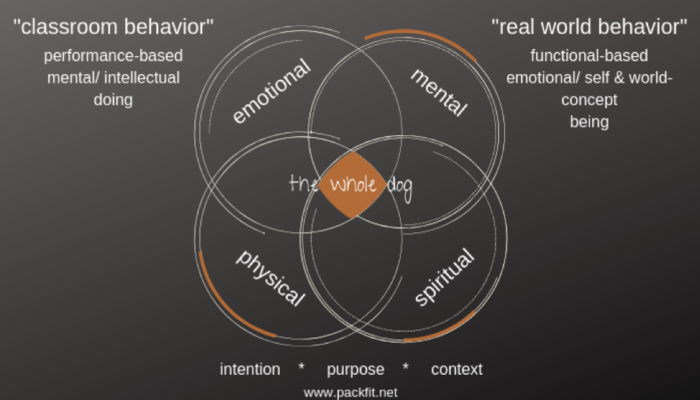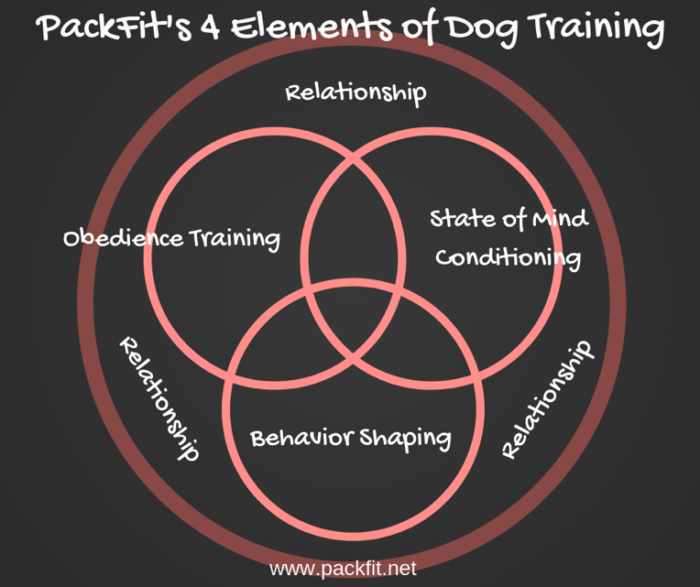This post is written by Honey Good Guest Contributor Kimberly Artley. Kimberly is an amazing dog trainer and behaviorist. We’re certainly lucky to have her on the blog again this month. I hope you enjoy, darlings!
Redefining Behavior
PACKFIT specializes in behavior and there are several contributing ingredients that influence, impact, and feed into this. There are varying definitions of “behavior” that exist in the dog training world. We thought we’d write a short post to decode this.
To effectively address behavior, it’s important to look at the dog in its entirety. Like humans, dogs have four different intersecting “bodies:” emotional, mental/intellectual, physical, and–if you ask us–spiritual (the energetic body). All of these connect with each other; each one impacts the next.

We break down “behavior” down into two categories. The first is classroom behavior, which shapes behavior around a specific goal and task that correlates to the mental body. Secondly, there’s real-world or functional behavior. This encompasses learning the difference between appropriate and inappropriate, relationship and association building, which correlates with the emotional body. A similar comparison arises with what we learn in school versus what we should learn at home.
Our focus is more on the real world and functional behavioral aspect of dog training. First of all, this helps our dogs develop healthy self and world concepts. These may include coping mechanisms during discomforting times, impulse control, relationship building through trust, cleaning up obedience and the walk. Moreover, our focus reflects the relationship the dog has with his or her human. It also reflects a dog’s “self” and “world concept.” The human ingredient is a major contributor because a dog’s instinctual, individual and breed-specific needs also play a part.
Holistic Training Approach
We call our approach holistic training. To address real-world and functional behavior, we speak to all four intersecting bodies of a dog’s being. Next, we craft a training program around our Four Elements of Dog Training. Our four-part program includes Foundational, Obedience, State of Mind Conditioning, and Behavior Shaping.
Foundational training includes building and solidifying relationships. Certainly, this is one of the most important ingredients of training and behavior. The foundation of any sound relationship includes trust and respect. If these don’t exist between dogs and their owners, the dogs may give the metaphorical middle finger with each direction.
Obedience Training
Obedience training is brain training. Above all, brain training means subscribing to verbal cues and commands such as sit, down, off, come and place.
State of Mind Conditioning measures a dog’s level of excitement and arousal. State of mind fuels any given behavior, as excitement induces many of the problematic behaviors we deal with. We condition calm–why and how we do this will be an entirely different post. As a result, we can better manage and control the rest of the body. The body always follows the mind.
There’s a big difference between a well-trained dog and a well-behaved dog; ideally, we’ll have both. However, neither arrive without an investment of our time, energy, attention, and consistent effort.

The obedience, agility or vocational side of dog training might define behavior as assisting in certain activities. We define it as a “manner of expression” and an “external manifestation of an underlying internal driving force.” The only differences are that of context, intention and purpose. One is performance-based through classroom behavior, which speaks to the mental body of the dog. In contrast, the other is more functional in nature, which speaks to the emotional body of the dog.
Behavior is fascinating and it demonstrates how our dogs communicate with us. It shows us where we can meet their needs. What they enjoy versus what they don’t–their level of comfort, safety and security. For that reason, it’s all information.
Have questions for Kimberly Artley on dogs and behavior? Join the conversation in the comments below!
 Kimberly Artley is the Founder of PACKFIT: Dog Training and Behavior, author of the celebrated book, “My Dog, My Buddha“. She has been described as the “Mary Poppins” of dog training. Her experience stems from her “game changer dog” Lobo. In addition, her background of nutrition, psychology, learning, and human/canine behavior blend seamlessly together. This allows Kimberly to take a comprehensive approach to successfully address a wide variety of canine behavioral challenges.
Kimberly Artley is the Founder of PACKFIT: Dog Training and Behavior, author of the celebrated book, “My Dog, My Buddha“. She has been described as the “Mary Poppins” of dog training. Her experience stems from her “game changer dog” Lobo. In addition, her background of nutrition, psychology, learning, and human/canine behavior blend seamlessly together. This allows Kimberly to take a comprehensive approach to successfully address a wide variety of canine behavioral challenges.

+ show Comments
- Hide Comments
add a comment